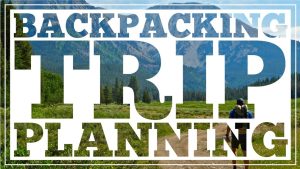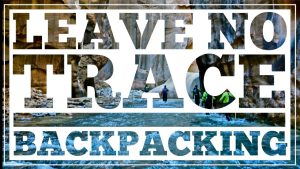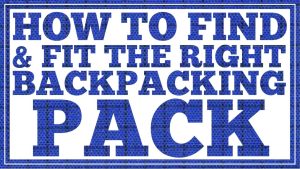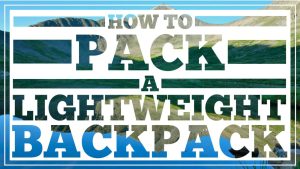Ep. 20 – Backpacking Hygiene – Keeping Clean in the Wilderness
We independently test everything we recommend.
Buying through links on our site supports our work.
In this episode we’ll be taking a look at keeping clean on the trail.
No matter what you do, staying clean on the trail will always be a difficult task, but it might not be as hard as you think.
Keeping good trail hygiene is an important part of staying healthy and feeling good while you backpack.
—
One of the most important parts of trail hygiene is keeping your hands clean, especially after bathroom breaks or before eating food.
Hikers often blame illness on poor water sources, but it is more likely a case of poor trail hygiene.
Use a combination of hand sanitizer and biodegradable soap to clean your hands. Hand sanitizer is a quick and easy way to clean. You’ll want to use often and keep it in an accessible location.
When you want a deeper clean, use biodegradable soap. Never bring regular soap into the wilderness because it can be harmful to the ecosystem.
Make sure to walk at least 200 feet away from water sources when you use bio soap so it won’t contaminate the water. Repackage your soap in a small container because a little bit will go a long way.
—
Keeping your body clean is slightly more challenging while backpacking, but it’s still very possible to do.
While you’re hiking, you’re going to sweat, so at the end of the day it’s going to feel pretty sticky if you climb straight into your sleeping bag without washing up a bit.
But practicing good trail hygiene is more than just a way to feel clean and sleep comfortably. You’ll also reduce odors and the risk of chafing, rashes, and other harmful bacteria.
A bandana, a small trail towel, wet wipes, hand sanitizer, and a small container of biodegradable soap are more than enough to keep you clean in the wilderness for a very long time.
There are a few ways to clean up after a long day’s hike, and every hiker has their preferred method. Wiping down with a bandana, using body wipes, or taking a trail shower are a few of the preferred methods.
If you’re camping near a water source, you could always consider taking a quick dip to clean off, but it’s important to remember the leave-no-trace principles.
Don’t disrupt an animal’s path to a water source, especially at dawn or dusk, and make sure that you’re not polluting the water with residues from your skin like soap or bug spray.
To take a trail shower, you can use a water bottle or a water bladder. Walk at least 200 feet away from any water source and use biodegradable soap and a bandana to thoroughly wash your body. This is a great way to feel completely clean after a long day’s hike.
You can also use a wet bandana or body wipes to clean off grime from the day. Make sure to thoroughly clean your hands, face, underarms, groin, butt, inner thighs, and feet.
It’s a good idea to clean up and change into camp clothes as soon as you finish hiking for the day. Most water sources will be very cold and it will feel much better if you clean up while you’re still feeling hot from the day’s hike.
Also, if you clean up before changing clothes, your camp clothes will stay cleaner longer.
—
Use quick-drying synthetic clothing so you can rinse it off and dry it out quickly. This will help to reduce odors and make your clothes feel clean.
If you wash your hiking clothing and ring it out at night, it will often be mostly dry by the time you start hiking in the morning.
You can also rinse synthetic clothes and hang them off the back of your pack to dry while you hike. Make sure to attach clothing items securely though, so they don’t get pulled off and left behind if they get caught on a branch.
Another good time to wash your hiking shirt is while you’re hiking on a hot day. Pour water from a cold stream on your shirt, wring it out, and put it right back on. It will feel very nice against your skin and it will dry again quickly.
When it’s time for bed, consider changing into lightweight long john top and bottom layers. Wearing dirty clothes to bed will make the inside of your sleeping bag dirty and very smelly.
—
As you take breaks throughout the day, consider taking off your shoes and washing your feet in a creek. It’ll feel extremely refreshing, energy rejuvenating, and your feet are an important part of your body to keep clean.
Chafing can be an incredibly uncomfortable problem when backpacking, especially if you’re hiking long miles or thru-hiking.
Treat chafing like you would treat a blister, stop as soon as you start to feel any pain and address the problem immediately before it gets worse.
Chafing can sometimes be an issue of a poorly fitting piece of clothing or pack that rubs against your skin while you hike. It can often be prevented with moisturizers, sports lubricants, or petroleum jelly.
Deodorant isn’t considered necessary on the trail and it can actually be harmful. Deodorants can attract bugs and animals, like mosquitoes and bears.
You’re going to smell bad on the trail, but you’ll get used to it quickly and your hiking partners won’t even notice, so leave the deodorant at home.
You’ll also want to leave shampoo, conditioner, razors, cosmetics, and any perfumes or colognes at home. Those items aren’t necessary on the trail and aren’t eco-friendly either.
For your toiletry kit, bring just the basics and bring them in small quantities. Repackage your toiletries in small plastic containers to save weight and only bring the amount of toiletries that you’ll need for the number of days you’ll be on the trail.
Your total toiletries kit should contain:
- A bandana
- Small quick-dry towel
- Hand sanitizer
- Biodegradable soap
- Moist towelettes (optional)
- Sunscreen
- Lip balm
- Bug spray
- Lotion for chafing
- Gold bond (optional)
- 1 small tube of toothpaste
- Toothbrush cut in half
- Floss (optional)
- Pain medication
- Personal medications etc.
- Toilet paper (pack it out)
Your toiletries kit will be very light but it’ll contain everything you need to keep yourself clean for a long trip in the woods.
With a little practice, you’ll quickly find the hygiene techniques that work best for you and you’ll easily stay clean and comfortable on the trail.
You’ll also find that a warm shower after a long trek in the woods will be one of the best parts of getting back to civilization.
Hike light, hike smart, and have fun!
MORE EPISODES IN THIS SERIES
View all





